8 - Automate Probabilistic Analysis
1.0 Introduction
The Automate Compute option helps users quickly generate results for several RocSupport analysis cases at a time by reading in various model inputs from Excel. In this tutorial, we will familiarize you with the Automate Compute feature by automating the computation of three unique Probabilistic analysis cases, each with 10,000 samples (i.e., 3 x 10,000 = 30,000tunnel cases).
Topics Covered in this Tutorial:
- Probabilistic Analysis RocSupport Model
- Input Excel File Format
- Adding Input Excel File(s) to Automate Compute File Queue
- Output RocSupport Automate Compute Results File
- RocSupport Automate Compute Error Log
Finished Product:
The finished products of this tutorial can be found in the Tutorial 8 Automate Compute - Probabilistic Analysis folder, located in the Examples > Tutorials folder in your RocSupport installation folder. Inside, you will find:
- Tutorial 08 Automate Compute - Probabilistic_base file.rsp RocSupport model file setup for automation
- Tutorial 08 Automate Compute - Probabilistic_inputs.xlsx Excel input file
- Tutorial 08 Automate Compute - Probabilistic_inputs folder containing the computed results files
2.0 Creating a New File
If you have not already done so, run the RocSupport program:
- Double-click the RocSupport icon in your installation folder or select Programs > Rocscience > RocSupport > RocSupport in the Windows Start menu.
When the program starts, there are no Models loaded. You need to create a new project as follows:
- Select: File > New

Whenever a new file is created, the Ground Reaction View is displayed. The view shows the Ground Reaction Curve based on the default Tunnel and Rock Parameters.
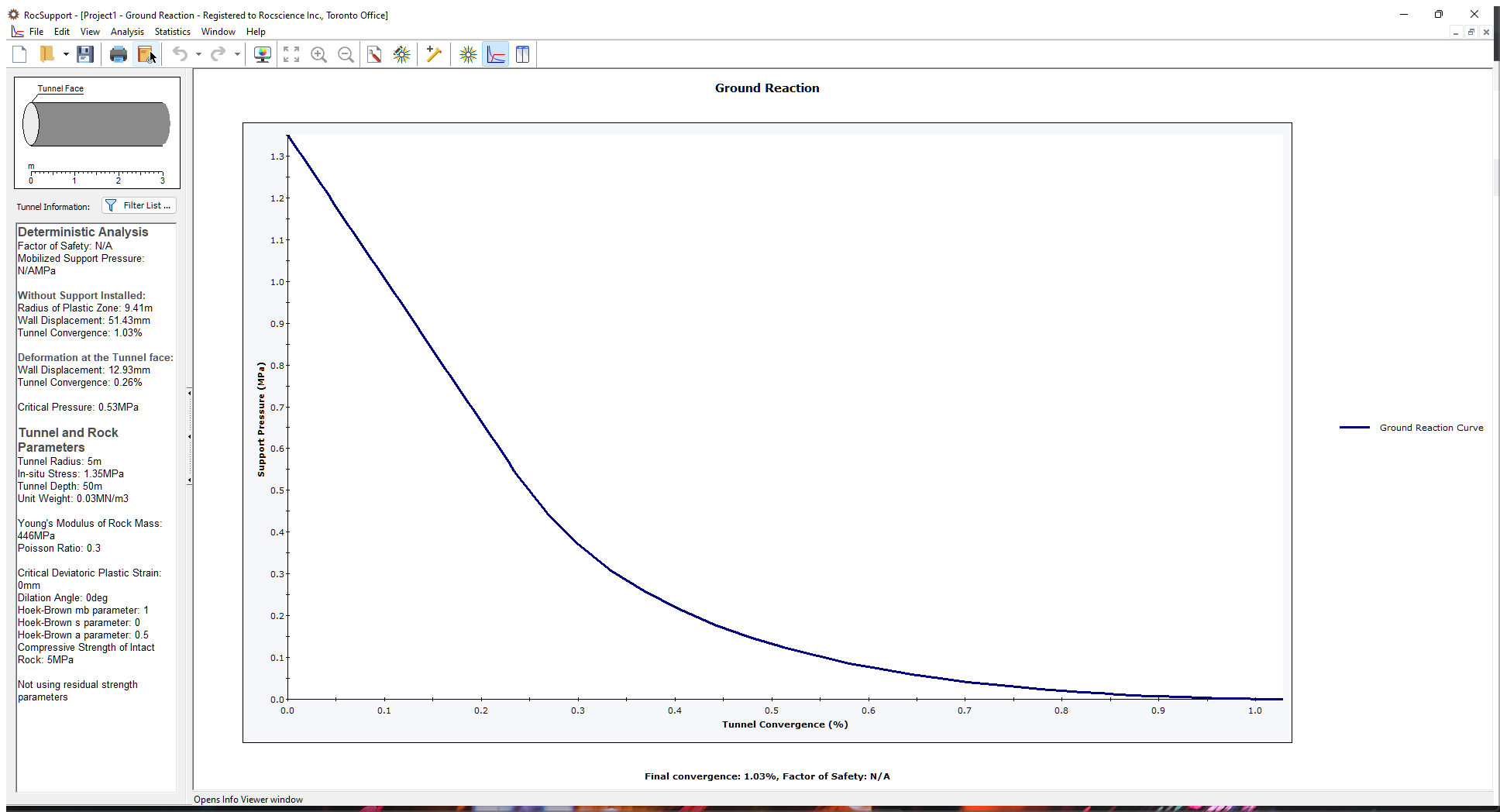
If the RocSupport application window is not already maximized, maximize it now so that the full screen is available for viewing the model.
Before we are ready to run the Automate Compute, we must first set up the model environment in the following dialogs:
- Project Settings
- Tunnel and Rock Parameters
- Support Parameters
3.0 Project Settings
First, set the model Units, and Analysis Type.
- Select Project Settings
 from the Analysis menu to open the Project Settings dialog.
from the Analysis menu to open the Project Settings dialog. - Set the Units = Metric, stress as MPa
- Set the Analysis Type = Probabilistic
- Set Solution Method = Vrakas and Anagnostou (2014)
- Set Modulus Estimation Method for Generalized Hoek-Brown Materials = Simplified Hoek-Diederichs (2006)
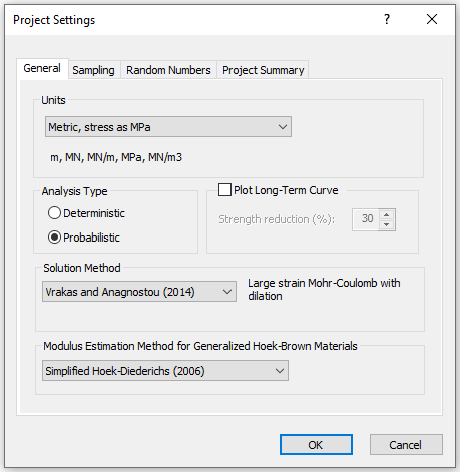
- Set the Sampling Method = Latin Hypercube
- Set the Number of Samples = 10,000
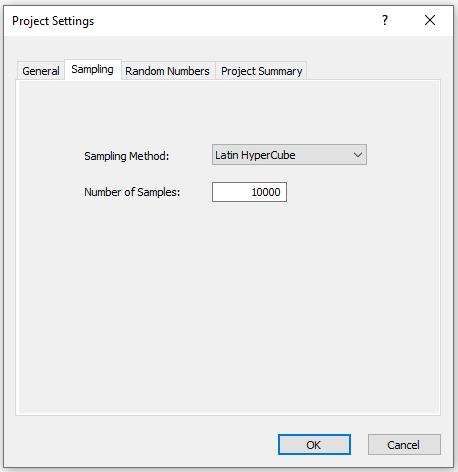
- Select the Pseudo-random (constant seed value) radio button option.
- Set the Number Generator = Park and Miller v.3
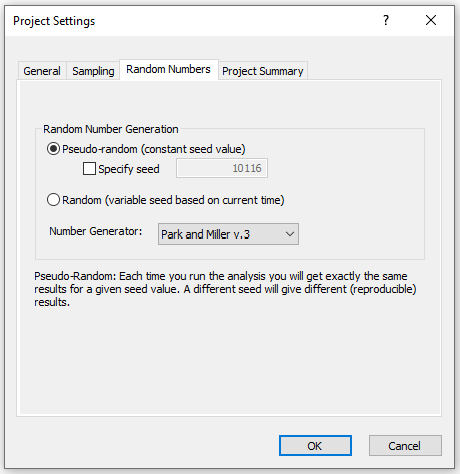
- Select OK to close the dialog.
4.0 Tunnel and Rock Parameters
Next, set the optional Tunnel and Rock Parameters.
- Select Define Tunnel Parameters
from the Analysis menu to open the Probabilistic Tunnel and Rock Parameters dialog.
- Click on the Use Compressive Strength radio box
- Set the Tunnel Radius = Normal
- Set the Poisson Ratio = Normal
- Set the Compressive Strength of Rock Mass = Normal
- Keep all other Statistical Distributions = None. Keep in mind that the following are required input parameters that have to be specified later on in the Input Excel File:
- Tunnel Radius Mean, Standard Deviation, Relative Minimum, and Relative Maximum
- In-Situ Stress Mean
- Young's Modulus of Rock Mass Mean
- Poisson Ratio Mean, Standard Deviation, Relative Minimum, and Relative Maximum
- Compressive Strength of Rock Mass Mea, Standard Deviation, Relative Minimum, and Relative Maximum
- Friction Angle Mean
- Dilation Angle Mean
- Select Apply and click Close to close the dialog.
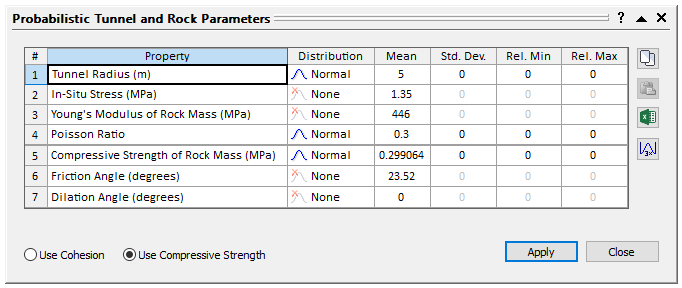
5.0 Support Parameters
- Select Support Parameters
 from the Analysis menu to open the Support Parameters dialog.
from the Analysis menu to open the Support Parameters dialog. - Navigate to the Steelsets tab and click on the Add Support radio box.
- Keep all other check box controls in the default state. Keep in mind that the following are required input parameters that have to be specified later on in the Input Excel File:
- Cross sectional area
- Yield Strength
- Young's modulus
- Out of Plane Spacing
- Distance from tunnel face
- Select Apply and click Close to close the dialog.
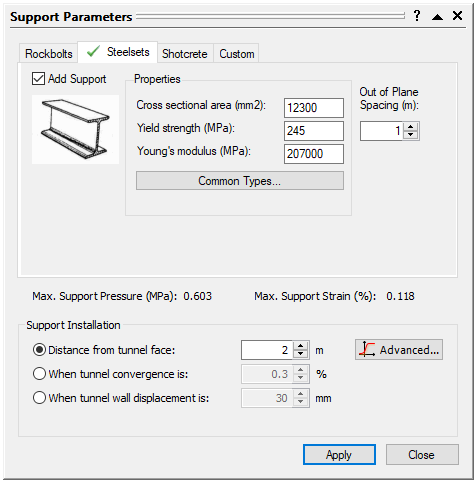
6.0 Input Excel File
Now, let's take a look at the structure of the input Excel file.
- Obtain the RocSupport Probabilistic Excel Template by selecting Analysis > Automate Compute > Probabilistic Excel Template from the menu.
A Read-Only Excel workbook titled RocSupport Automation Template_Probabilistic.xlsx will be automatically opened (if you have Excel installed on your local machine).
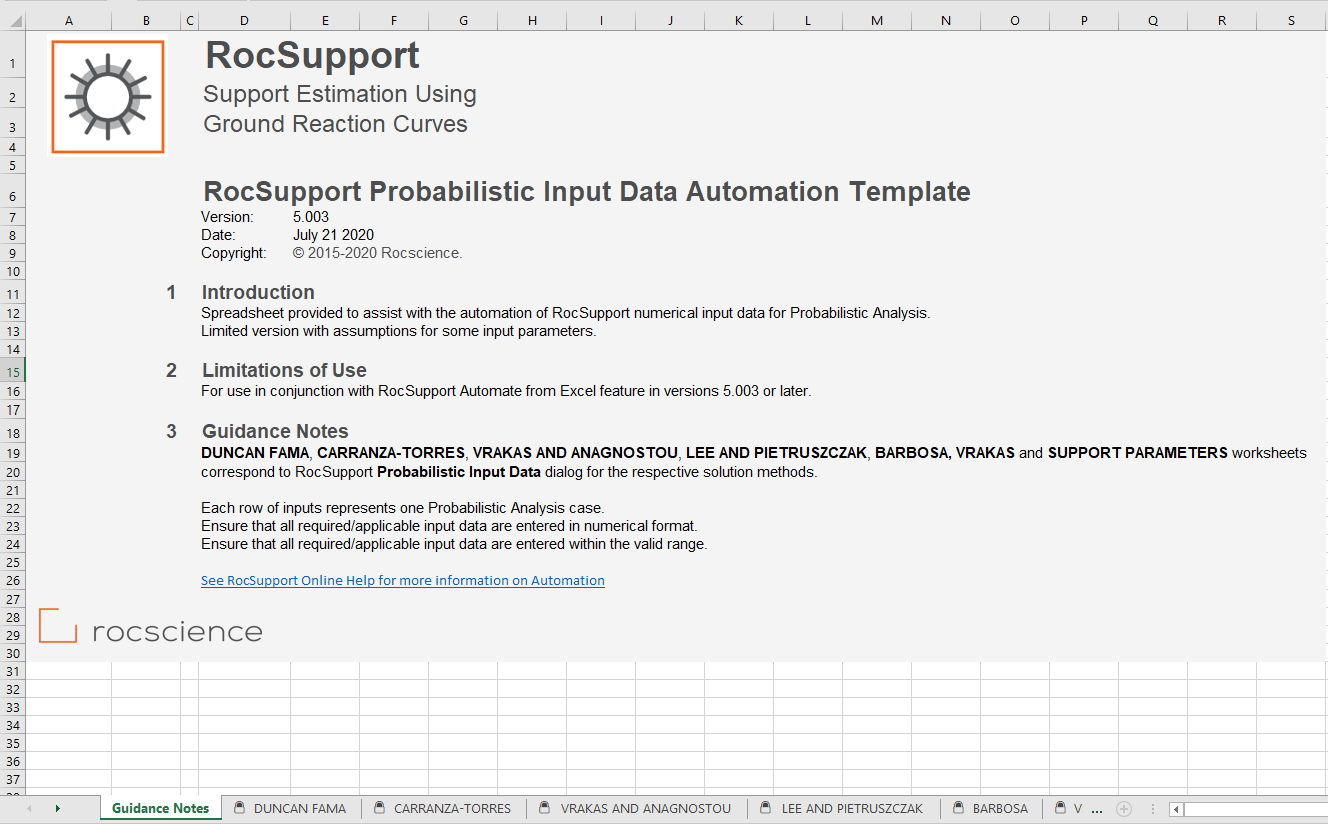
The RocSupport Probabilistic Input Data Automation Template Excel workbook and worksheets are protected to prevent any accidental modification to the tab structure and headers. The input Excel template contains 7 worksheets for inputting numerical parameters for automation.
- Create a folder called Tutorial 8 Automate Compute - Probabilistic.
- Navigate to the VRAKAS AND ANAGNOSTOU worksheet
Each worksheet contains fields for the necessary inputs related to each solution method available in RocSupport. For this tutorial, we will choose the Vrakas and Anagnostou method.
- Under the Tunnel ID column, provide the names of the tunnel cases. We will name them arbitrarily Tunnel A, Tunnel B, and Tunnel C. Each row in the input Excel file represents one Probabilistic Analysis case in RocSupport.
- Enter the following:
Tunnel ID | Tunnel Parameters | ||||
Radius | In-Situ Stress | ||||
Mean | Std. Dev. | Rel. Min. | Rel. Max. | Mean | |
Tunnel A | 6.8 | 1.0 | 3.6 | 3.6 | 1.5 |
Tunnel B | 7.5 | 1.2 | 3.0 | 3.0 | 2.5 |
Tunnel C | 7.2 | 1.3 | 3.9 | 3.9 | 2.2 |
Rock Parameters | ||||||||||
Young's Modulus | Poisson Ratio | Compressive Strength | Friction Angle | Dilation Angle | ||||||
Mean | Mean | Std. Dev. | Rel. Min. | Rel. Max. | Mean | Std. Dev. | Rel. Min. | Rel. Max. | Mean | Mean |
506 | 0.32 | 0.01 | 0.03 | 0.03 | 0.4 | 0.1 | 0.30 | 0.30 | 23.52 | 0 |
606 | 0.35 | 0.01 | 0.03 | 0.03 | 0.38 | 0.08 | 0.24 | 0.24 | 23.52 | 0 |
600 | 0.28 | 0.02 | 0.06 | 0.06 | 0.45 | 0.12 | 0.36 | 0.36 | 25 | 5 |
The VRAKAS AND ANAGNOSTOU worksheet should look like this:

- Navigate to the SUPPORT PARAMETERS worksheet.
- Under the Tunnel ID column, provide the names of the tunnels (Tunnel A, Tunnel B, and Tunnel C).
- Enter the following:
Tunnel ID | SUPPORT PARAMETERS | ||||
Steelsets Properties | Support installation | ||||
Cross section area | Yield strength | Young's modulus | Out of Plane spacing | Distance from tunnel face | |
Tunnel A | 12300 | 245 | 207000 | 1.3 | 2.2 |
Tunnel B | 14500 | 250 | 217000 | 1.1 | 2 |
Tunnel C | 15000 | 270 | 220000 | 1.5 | 2 |
The SUPPORT PARAMETERS worksheet should look like this:

- Save the Excel file as Tutorial 7 Automate Compute - Probabilistic_inputs.xlsx to the Tutorial 7 Automate Compute - Deterministic folder previously created
We are now ready to automate computations in RocSupport by reading from the input Excel file.
7.0 Automate from Excel
- Return back to the RocSupport model.
The Automate Compute dialog allows you to add Excel input automation files to the queue, select an output format, and compute the results. To open the dialog:
- Select: Analysis > Automate Compute > Automate from Excel

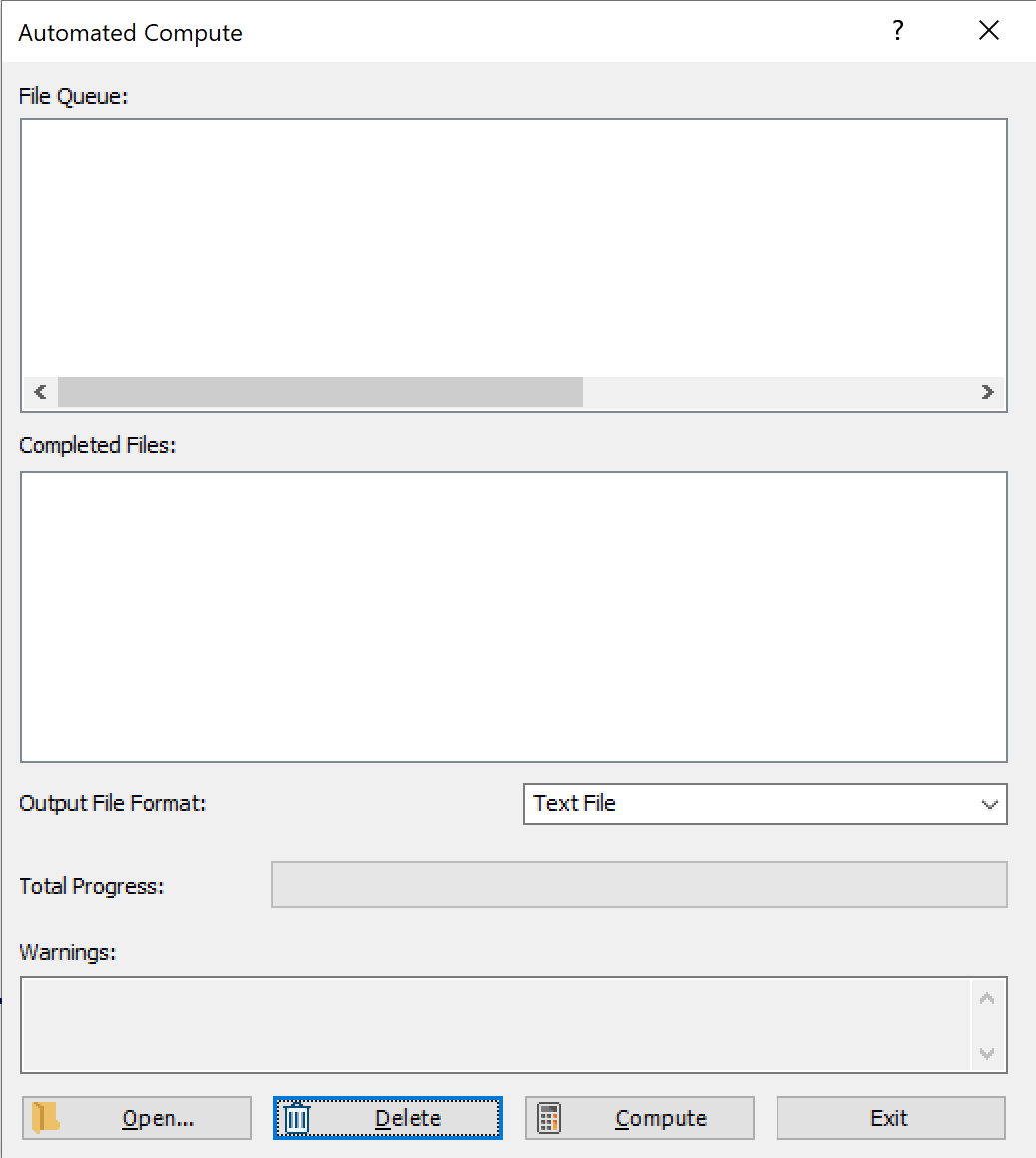
7.1 ADD FILES TO FILE QUEUE
To add multiple files to the File Queue:
- Select Automate from Excel
 from Analysis menu to open the Automated Compute dialog.
from Analysis menu to open the Automated Compute dialog. - Select the Open
 button to open a standard dialog to choose an Excel input file. Navigate to the Tutorial 8 Automate Compute - Probabilistic folder and select the Tutorial 8 Automate Compute - Probabilistic_inputs.xlsx file.
button to open a standard dialog to choose an Excel input file. Navigate to the Tutorial 8 Automate Compute - Probabilistic folder and select the Tutorial 8 Automate Compute - Probabilistic_inputs.xlsx file.
You will see the Excel input file appear under the File Queue list box.
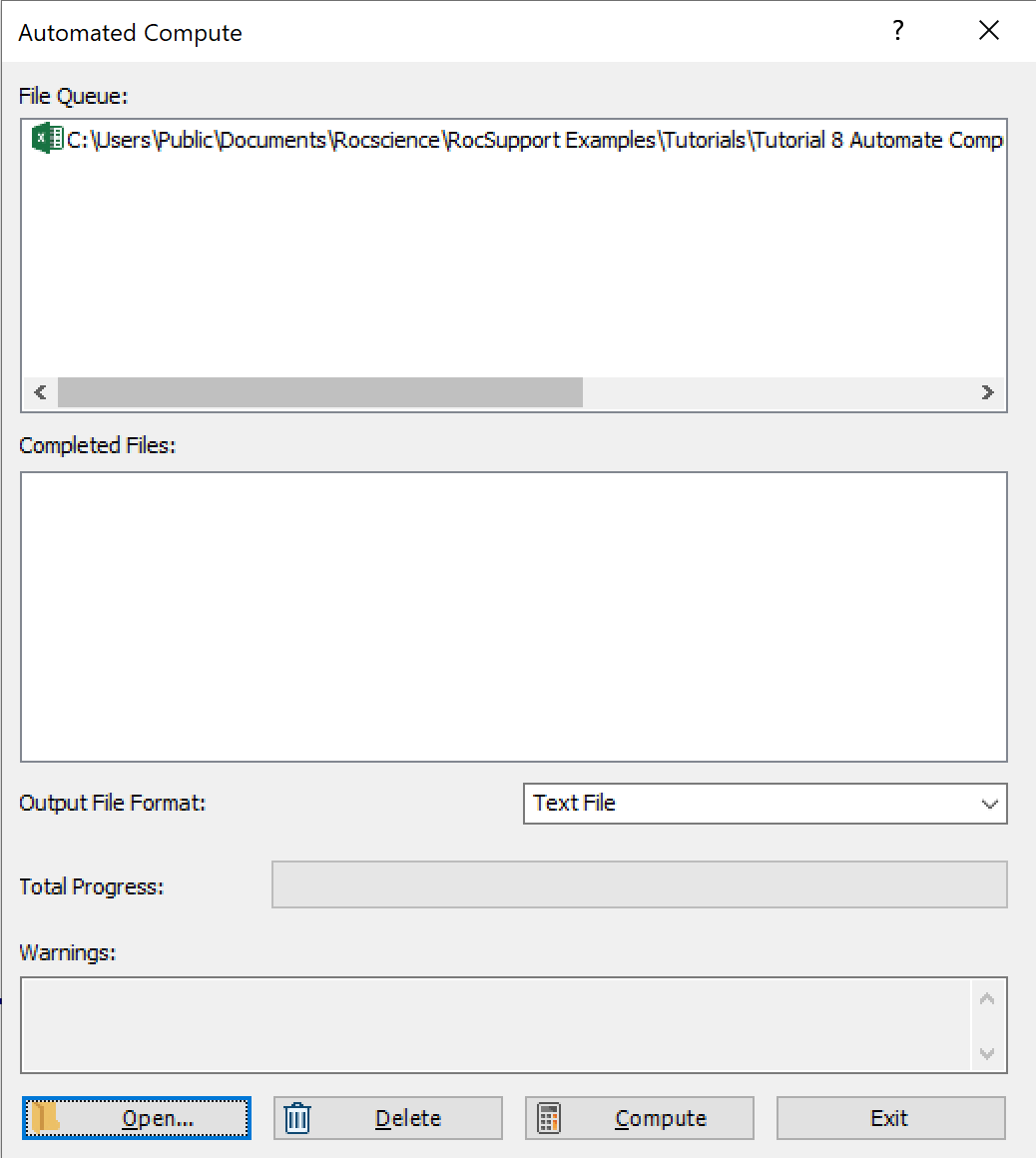
8.0 Output Result Files
Results files are automatically generated and saved into the same directory as the input Excel file after Automated Compute is complete. Before we run Compute, first ensure that the Output File Format is set to the desired format. Users can select from either Test File or Excel format.
8.1 TEXT FILE FORMAT
While still in the Automated Compute dialog:
- Set the Output File Format dropdown to Text File.
- Select the Compute button to start the automated computing process
The Total Progress can be seen at the bottom of the dialog. When files have finished computing, they will appear in the Completed Files list box.
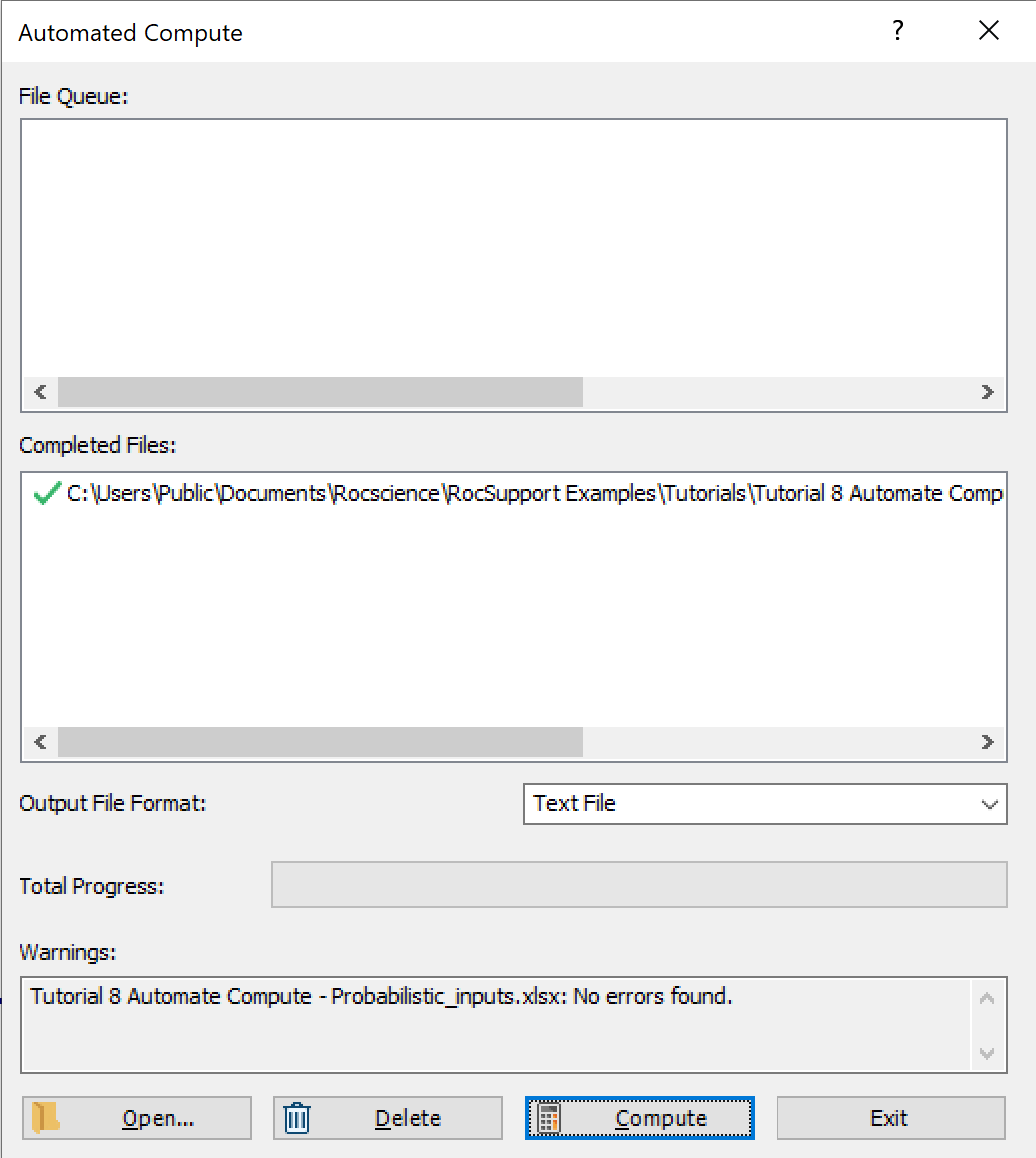
- When all files have finished computing, select Close to exit the dialog.
For each input Excel file, a test file (.txt) containing all results data is generated.
For a Probabilistic Analysis (Tutorial 8 Automate Compute - Probabilistic_inputs.xlsx), the results data for each case are output to a separate text file since each case tends to contain hundreds or thousands of tunnel samples. Inside each text file, results for all probabilistic tunnel samples in the case are outputted following the header row. Each row of data represents one sample tunnel case. Each data type is separated by a comma (,) for easy parsing.
- Take a look at the ResultsTunnel A[0].txt result file
![ResultsTunnel A[0].txt result file](/assets/help/rocsupport/images/image/tutorials/t08/output_rslts_smpl_txt_rslts.png)
Note that a total of 3 files with the same format (i.e ResultsTunnel A[0].txt, ResultsTunnel B[1].txt, ResultsTunnel C[2].txt) have been created; one file per case.
8.2 EXCEL FILE FORMAT
Now, we will do the same as before, but this time we will generate the results as an Excel output file format.
- Select Automate from Excel
 from the Analysis menu to open the Automated Compute dialog
from the Analysis menu to open the Automated Compute dialog - Select the Open
 button to open a standard dialog to choose an Excel input file. Navigate to the Tutorial 8 Automate Compute - Probabilistic folder and select the Tutorial 8 Automate Compute - Probabilistic.xlsx file.
button to open a standard dialog to choose an Excel input file. Navigate to the Tutorial 8 Automate Compute - Probabilistic folder and select the Tutorial 8 Automate Compute - Probabilistic.xlsx file.
You will see the Excel input file appear under the File Queue list box.
- Set the Output File Format dropdown to Excel
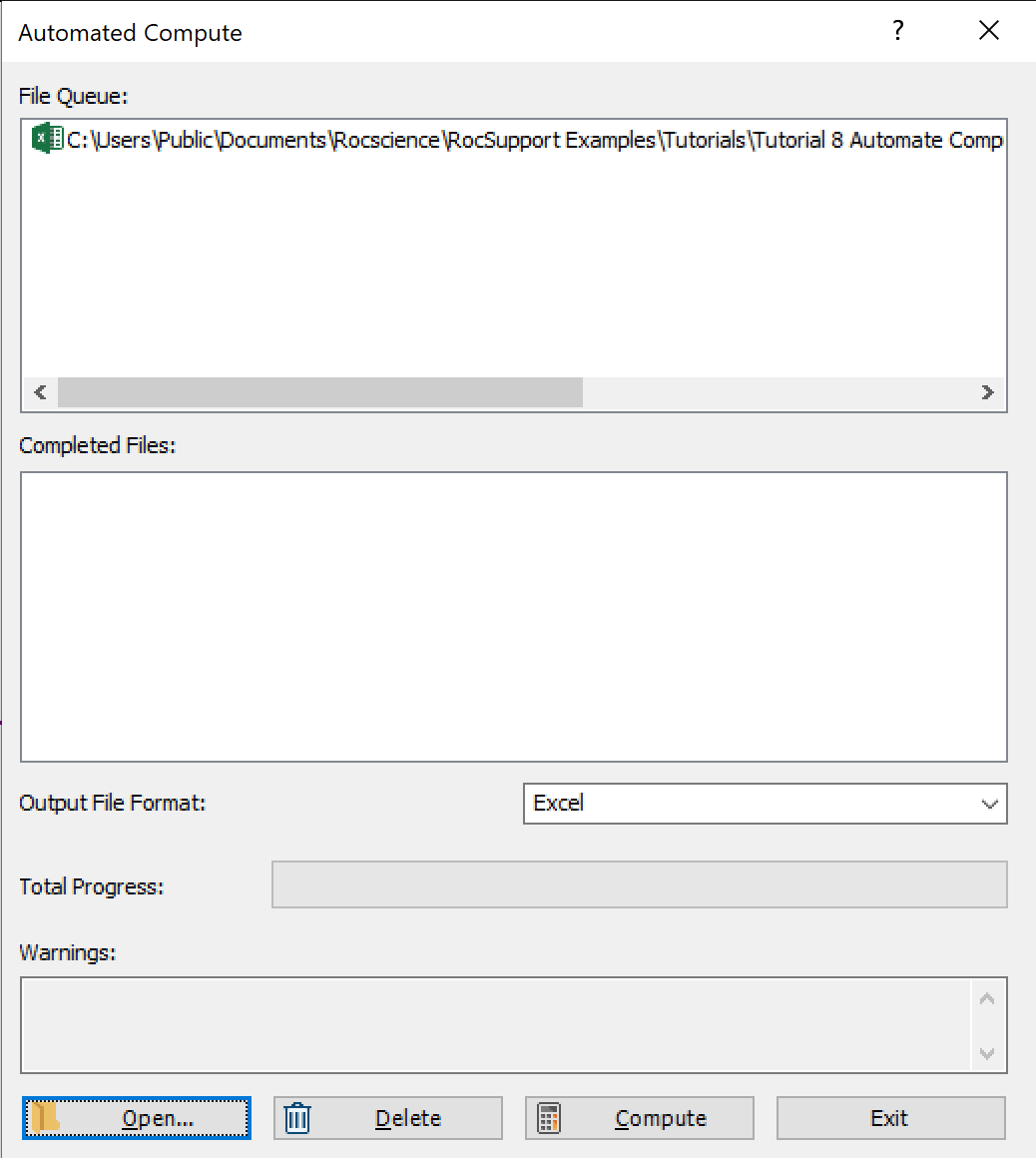
- Select theCompute button to start the automated computing process.
- When all files have finished computing, select Close to exit the dialog.
For each input Excel file, an Excel file (.xlsx) containing all results data is generated.
For a Probabilistic Analysis (Tutorial 8 Automate Compute - Probabilistic.xlsx), the results data for each case are output to a separate Excel file since each case tends to contain hundreds or thousands of tunnel samples. Inside each Excel file, results for all probabilistic tunnel samples in the case are outputted following the header row. Each row of data represents one sample tunnel case. Each data type is separated by a column.
- Take a look at the ResultsTunnel A[0].xlsx result file.
![ResultsTunnel A[0].xlsx result file.](/assets/help/rocsupport/images/image/tutorials/t08/output_rslts_smpl_excel_rslts.png)
Note that a total of 3 files with the same format (ResultsTunnel A[0].xlsx, ResultsTunnel B[1].xlsx, ResultsTunnel C[2].xlsx) have been created; one file per case.
9.0 Error Log
As you may have noticed, an Error Log is also generated for each input Excel file. For each input Excel file, an Error Log text file (Automate Compute Error Log.txt) is generated, and saved into the same directory as the output file directories. Always check that the Error Log reports "No errors found" before post-processing the raw results data. If any errors do occur as a result of missing (i.e., blank cells) or invalid inputs, the Error Log will indicate which worksheet(s) and cell(s) are problematic.
This concludes the tutorial. You are now ready for the next tutorial, Tutorial 09 - Convergence-Confinement Method for TBM segmental lining design (Almog et al. 2015).